Becoming bird observers
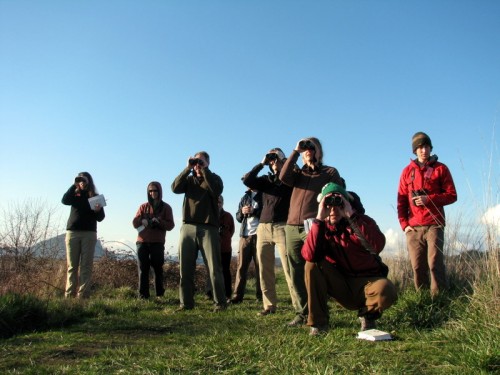
A flit of gold. A flicker of green. Soft song notes from within a tangle of blackberry vines. A surprising whoosh of hovering wing-sweeps, mere inches above ground.
Birds. They are some of the Skagit Valley’s most compelling and charismatic creatures. In winter, the Skagit farmlands teem with all kinds – song birds, raptors, shorebirds, local and migratory waterfowl. You need not have fancy equipment nor years of experience to be a birder here. What it takes is the curiosity to know more and the patience to practice deep observation.
 (Title) Graduate students of Cohort 9 extend their birding eye on the Skagit flats (Above) The Hayton Reserve is one Skagit Valley location to go bird watching
(Title) Graduate students of Cohort 9 extend their birding eye on the Skagit flats (Above) The Hayton Reserve is one Skagit Valley location to go bird watching
On February 8th, graduate students of Cohort 9 of the North Cascades Institute’s Masters Program were called to the lowlands of the Skagit River to accompany Institute staff member and graduate program alumnus, Megan McGinty, for a day brim-full of bird watching fun. The day began at the Port Susan Bay Preserve, a track of land owned by The Nature Conservancy of Washington, near the mouth of the Stillaguamish River, southwest of Stanwood. A young Bald Eagle, perched atop an old telephone pole, welcomed us as we were introduced to using a birder’s field guide such as The Sibley Field Guide to Birds of Western North America and assembling a spotting scope to view birds from a distance without disturbing them.
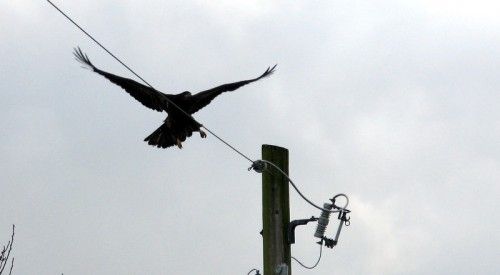 A young bald eagle lands atop a telephone pole
A young bald eagle lands atop a telephone pole
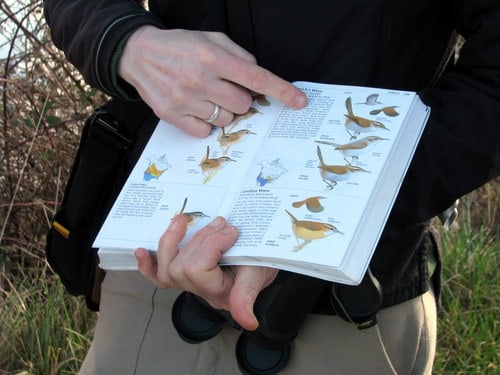 Explaining the various parts of a bird watcher’s field guide
Explaining the various parts of a bird watcher’s field guide
The Port Susan Bay Preserve is composed predominantly of wetland and estuarine habitat – critical for birds, salmon and other wildlife – and is accessible by trail on an embankment adjacent to the bay. Within only a few steps, our gaze was directed to several young bald eagles calmly perched on large drift logs in the marshlands. One step further, we could hear the call of the red-winged blackbird and spotted some swallows in a small deciduous shrub with our binoculars.
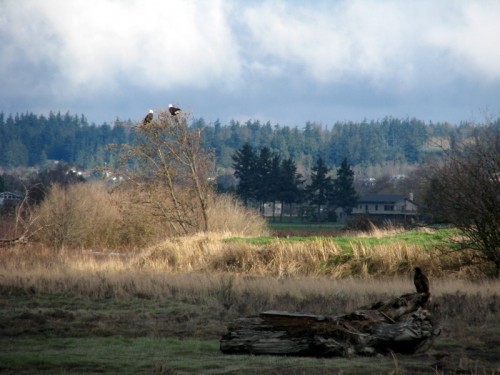 A young bald eagle sits atop driftwood as two adult bald eagles perch in a tree
A young bald eagle sits atop driftwood as two adult bald eagles perch in a tree
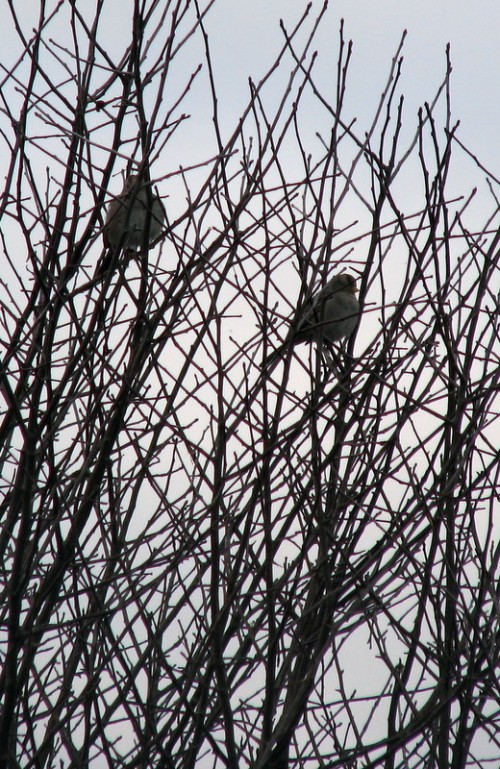 Two sparrows sit among deciduous shrub branches
Two sparrows sit among deciduous shrub branches
An American Bittern – a rare sight in this area – swung past us on our right, while a Northern Harrier drifted stealthily above the ground searching for prey in the reeds. In the distance we could see thousands of Snow Geese coming in off of the bay to the farm fields, their noisy calls unmistakable and their white bodies like falling flecks of snow.
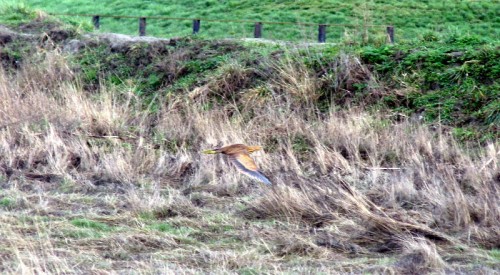 Look closely, the American Bittern sweeps across the marsh landscape
Look closely, the American Bittern sweeps across the marsh landscape
 A Spotted Towhee poses scratches at the ground, a signature behavior of the Towhee
A Spotted Towhee poses scratches at the ground, a signature behavior of the Towhee
 Cohort 9 examines the anatomy of a Snow Goose’s right wing
Cohort 9 examines the anatomy of a Snow Goose’s right wing
For nearly two hours, we covered less than a quarter mile of trail in the preserve, yet in that time identified over ten bird species covering all of the birding bases – Trumpeter Swan, American Bittern, Sparrow, Red-Winged Blackbird, Spotted Towhee, Red-Tailed Hawk, Great Blue Heron, Northern Pintail, American Wigeon, American Crow, Northern Harrier, a lot of Snow Geese.
After exploring the Stillaguamish tidelands, we ventured north to the Hayton Reserve, a small section of land adjacent to Skagit Bay near Conway managed by the Washington Department of Fish and Wildlife. We not but opened our car doors when two Killdeer, which fall under the shorebird category, walked briskly by on their way to a gravel mound, a common place to find them nesting. While at the reserve, we observed the intriguing group behavior of dozens of American Wigeons, bathing themselves in a large puddle on local farmland. A medium-sized duck, the high shrieks of the Wigeon make me wonder if their call was the inspiration for the Rubber Ducky toys I was so fond on in my childhood.
 A Killdeer roaming the gravel parking lot at Hayton Reserve
A Killdeer roaming the gravel parking lot at Hayton Reserve
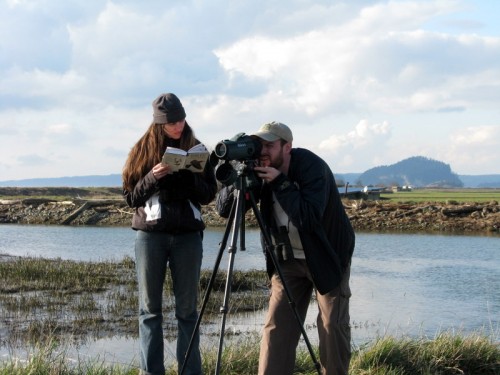 Erin Fowler uses a field guide while Justin McWethy observes American Wigeons
Erin Fowler uses a field guide while Justin McWethy observes American Wigeons
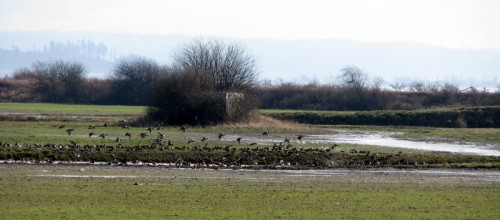 American Wigeon’s bathing on the Skagit farm fields
American Wigeon’s bathing on the Skagit farm fields
With the winter sun dwindling lower in the sky, our final destination of the day was along Maupin Road near the mouth of the North Fork Skagit River. Our hope was to catch a glimpse of one of the area’s only daytime owls—the Short-Eared Owl. Along the dike trail, we ran into several other bird enthusiasts who, coincidentally, proceeded to point out to us several short-eared owls in the distant tidelands. Not a pair of binoculars nor a set of eyes missed out on that unique sight.
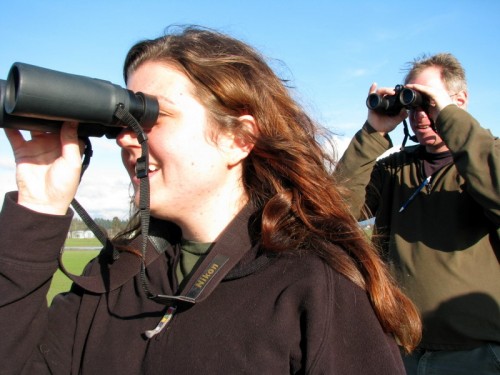 Brandi Stewart & Corey White observe Short-Eared Owls
Brandi Stewart & Corey White observe Short-Eared Owls
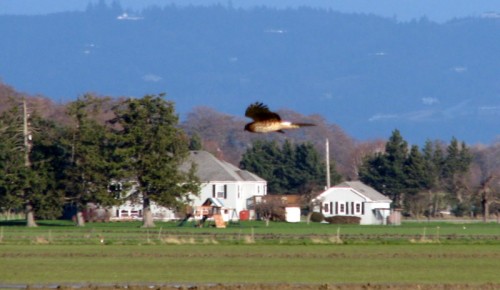 A Northern Harrier waves good-bye after a successful birding day
A Northern Harrier waves good-bye after a successful birding day
Just as we were greeted by the young eagle that morning, a Northern Harrier sent us home, twisting and diving among the driftwood, as if to wave goodbye. The magic of winter in the Skagit Valley is that among the farm fields, tidelands and weaving watercourses, you can see yourself more clearly through the bird watcher’s eyes, connecting deeper to the natural world through the power of mere observation.
If you are interested in taking up the sport of bird watching, the National Audubon Society has a great, user-friendly Birding Basics site that can help prepare you for your first birding experience. If you want to experience the birds before embarking into the field, check out The Cornell Lab of Ornithology’s All About Birds, which is both interactive and informative.
What birds have you observed in the Skagit Valley? Let us at Chattermarks know!


Nice job Kelsi – sounds & looks like you all had a great day. Dad and I will have to check this out for the future -it looks like fun! Thanks for your informative blogs.
Score…what a great day of birding! got to love the Skagit floodplain.